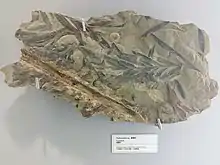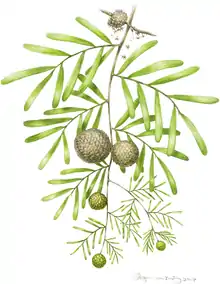Podozamites
Podozamites is an extinct genus of fossil conifer leaves. In its broader sense, it has been used as a morphogenus (form taxon) to refer to any broad leaved multi-veined conifer leaves, some of which probably belong to extant conifer groups including Araucariaceae. In a more narrow sense, it has been used to refer to a probably monophyletic group of deciduous broad leafed voltzialean conifers that existed in the Northern Hemisphere, particularly East Asia and Siberia during the Late Triassic to early Late Cretaceous, where it formed part of wet coal swamp communities.
| Podozamites | |
|---|---|
 | |
| Fossil Podozamites from China | |
| Scientific classification | |
| Kingdom: | Plantae |
| Clade: | Tracheophytes |
| (unranked): | Gymnosperms |
| Division: | Pinophyta |
| Class: | Pinopsida |
| Order: | †Voltziales |
| Family: | †Krassiloviaceae |
| Genus: | †Podozamites Braun 1843 |
Description

Podozamites leaves are thought to have been regularly shed. Podozamites leaves sensu stricto are associated with conifer cones of the genera Swedenborgia, Cycadocarpidium, and Krassilovia, which were suggested in 2020 to constitute the distinct family Krassiloviaceae within the Voltziales.[1] The paracyctic stomata and other morphological features of Krassiloviaceae are simiar to those of Gnetales, suggesting that they may be closely related.[1]
Evolutionary history
Podozamites sensu stricto first became widespread at mid-latitudes during the Late Triassic. During the Early Jurassic in East Asia, it formed almost monospecific assemblages where it was the dominant plant. Over the course of the Jurassic, the distribution shifted northwards in response to the drying of the lower latitudes, becoming restricted to between 60 and 30 degrees north by the Early Cretaceous. Podozamites senus stricto would become extinct during the Turonian stage of the Late Cretaceous, coincident with the arrival of flowering plants into the Siberian region.[2]
Species
A number of species within the genus were listed by Fossilworks, as of May 2021: Podozamites agardhianus, Podozamites distans, Podozamites lanceolatus, Podozamites longifolius, Podozamites mucronatus, Podozamites pinnatus and Podozamites schenki.[3] Agathis jurassica, initially identified as Podozamites lanceolatus, has also been placed in this genus.[4] Podozamites harrissii from the Early Cretaceous of Mongolia is associated with Krassilovia mongolica, while Podozamites schenkii is associated with the Triassic-Jurassic Swedenborgia cryptomerioides and Triassic Cycadocarpidium erdmanni.[1] It has been noted that extant Agathis (Araucariaceae) and Nageia (Podocarpaceae) qualify as members of Podozamites under its morphogenus sense.[2]
References
- Herrera, Fabiany; Shi, Gongle; Mays, Chris; Ichinnorov, Niiden; Takahashi, Masamichi; Bevitt, Joseph J.; Herendeen, Patrick S.; Crane, Peter R. (2020-01-15). Peppe, Daniel (ed.). "Reconstructing Krassilovia mongolica supports recognition of a new and unusual group of Mesozoic conifers". PLOS ONE. 15 (1): e0226779. Bibcode:2020PLoSO..1526779H. doi:10.1371/journal.pone.0226779. ISSN 1932-6203. PMC 6961850. PMID 31940374.
- Pole, Mike; Wang, Yongdong; Bugdaeva, Eugenia V.; Dong, Chong; Tian, Ning; Li, Liqin; Zhou, Ning (December 2016). "The rise and demise of Podozamites in east Asia—An extinct conifer life style". Palaeogeography, Palaeoclimatology, Palaeoecology. 464: 97–109. Bibcode:2016PPP...464...97P. doi:10.1016/j.palaeo.2016.02.037.
- †Podozamites Braun 1843 (conifer) at fossilworks.org
- Frese, M.; Gloy, G.; Oberprieler, R.G. & Gore, D.B. (2017). "Imaging of Jurassic fossils from the Talbragar Fish Bed using fluorescence, photoluminescence, and elemental and mineralogical mapping". PLOS ONE. 12 (6): e0179029. Bibcode:2017PLoSO..1279029F. doi:10.1371/journal.pone.0179029. PMC 5459505. PMID 28582427.